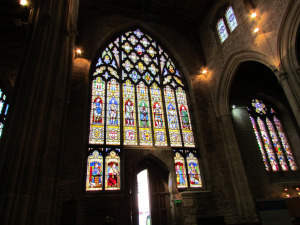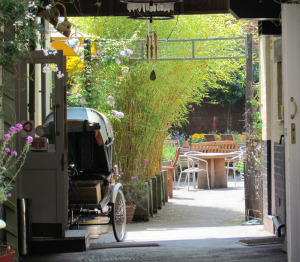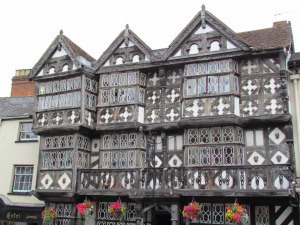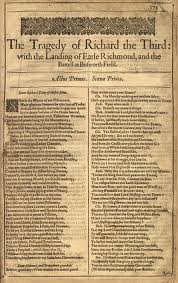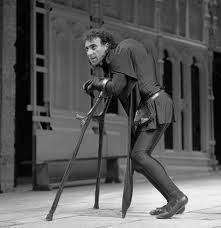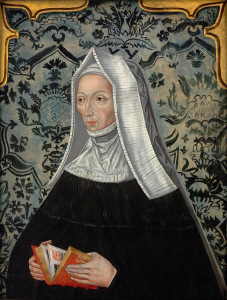Matthew Lewis's Blog, page 8
October 25, 2013
What If Richard III Did It?
What if we suppose that King Richard III did, in fact, order the killing of his nephews, Edward V and Richard of Shrewsbury, Duke of York. Let us suspend arguments about his previous character and the events that surrounded him in 1483 and presume him guilty of the killing of the Princes in the Tower. Controversial, I know, but since no one can currently prove him guilty or innocent, the argument is moot. It makes for fascinating debates and it never ceases to amaze me the passions it rouses, but without the sudden discovery of a lost cache of documents or perhaps Richard III’s diary (imagine the questions that might answer!), we will never be able to shed any more light on this mystery than has kept it gloomily illuminated for over 500 years.

The Princes in the Tower
This impasse provides an opportunity that I think receives less examination than it merits. If we were to presume that King Richard III had the boys killed, can his actions be justified? Clearly, by modern standards, no. But this did not take place in modern times. By the standards of his time, can any justification be offered if Richard III did order their deaths? If so, it takes some of the heat out of the debate about whether he did it or not.
The first thing to mention is that there is no evidence that medieval people would have been any less repulsed by the killing of children than we are now. Murder was still murder. It was a crime. Children were just as precious to our ancestors as they are to us. Richard III’s time was more brutal and death more common place perhaps but the murder of children was no less revolting then than it is now. By this measure, there can never be any excuse for Richard if he killed the Princes in the Tower in 1483, aged 12 and 9 (or 10, depending upon when it happened).
These were not, however, ordinary children. They were political beings. In this period of English history, ravaged by war and rivalries, this alters the landscape a little. Can this help to explain King Richard’s ‘actions’? It cannot be doubted that recent history would have warned Richard against allowing a child to sit upon the throne. Edward III’s grandson Richard II had ascended to the throne aged 10 in 1377. His father, the Black Prince, had died the year before Edward III and Richard’s powerful uncles, John of Gaunt, Duke of Lancaster, Thomas of Woodstock, Duke of Gloucester and Edmund of Langley, Duke of York were apparently not trusted. A regency was avoided and a system of continual councils put in place to assist the king during his minority. The Peasants’ Revolt of 1381 saw the 14 year old Richard emerge onto the political stage for the first time. He agreed terms with the rebels only to go back on his word and hunt them down. The harsh response was initially applauded by his nobles but it set a precedent that would see Richard descend into a period of tyranny, surrounded by unpopular advisors until, in 1399, he was relieved of his crown by his cousin, Henry Bollingbroke, son of John of Gaunt, who became King Henry IV, the first Lancastrian king. In 1400, amid plots to restore Richard, he was killed, possibly starved to death in his prison at Pontefract Castle. He could not be allowed to continue to live.
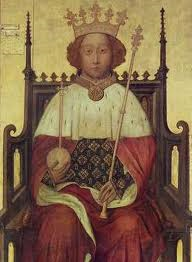
King Richard II
Henry IV’s own grandson was to provide the next lesson at the expense of the peace of a nation. Henry IV’s son, the mighty Henry V of Agincourt renown, died on campaign in 1422 aged 35, leaving his nine month old son, Henry VI, to take the throne amid raging wars in France. This time, with the prospect of well over a decade of royal minority, the new king’s uncles were vital to his security. John, Duke of Bedford acted as regent of France and
oversaw the wars there with some success, eventually defeating Joan of Arc and halting French resurgence. In England, Humphrey, Duke of Gloucester acted as his nephew’s Protector. Henry VI was declared of age in 1437. In 1441 Humphrey’s wife was arrested for sorcery and he was forced to retire from public life. In 1447 he was himself arrested and died in prison 3 days later. He may have suffered a stroke but there were whispered rumours that he had been poisoned.
Henry VI’s rule was to see the loss of all English territory in France apart from Calais and the eruption of the divisive and brutal Wars of the Roses. He surrounded himself with advisors that proved deeply unpopular and grew to be a weak and ineffectual king. Edward IV took his crown for the House of York and despite a brief reclaiming of his throne, once Henry’s only son was dead, Henry himself had met his end within the Tower of London. His continued existence could also no longer be tolerated.
If Richard sought a lesson from this period, it was that pretty clear.
Child kings did not bode well, not least for Protectors who were Dukes of Gloucester…..
When we look at Richard’s conduct in 1483, it must be against the backdrop of these events and all that they meant for England, because that is the only way in which Richard could have viewed them. The country had seen two changes in the ruling family in less than a century, both brought about by the failings of kings who had come to the throne as children. A third such event was potentially imminent and it was Richard’s family who stood to lose everything. No one could really be sure where a threat might come from. The Tudor family in exile, other vestiges of Lancastrian blood in Portugal or Spain. Louis XI, the Spider King, still ruled in France and may chose to seize upon any weakness he spied across the channel.
Personally, Richard’s position was precarious too. Edward IV had entailed his Neville inheritance, acquired through his wife Anne Neville, to male issue of the body of George Neville, Duke of Bedford. George had been disinherited to make way for Richard and this was meant as a mechanism for his protection. If the line failed, Richard’s interests would revert to life interests in the lands and titles so that he would be significantly weakened and his son would have no inheritance. Having spent so long so far north, Richard barely knew his nephew. He had been appointed Protector of the Realm for a boy he did not know and who did not know him. All of young Edward V’s ties and bonds were to his mother’s family who had raised him at Ludlow Castle. There is no real record of conflict between Richard and the Woodville’s before the summer of 1483 but their hold over the new king would have been a cause for concern to Richard if he was to act as Protector. Edward IV’s Chamberlain Lord Hastings had sent word to Richard even before he left the north that Elizabeth Woodville was planning to have her son crowned quickly in order to exclude Richard. Elizabeth’s son from her first marriage, Thomas Grey, Marquis of Dorset, was supposedly boasting that their family could rule without Richard, such was their grasp on power. What was he supposed to make of this situation?
Shortly after his arrival in London, word reached Richard that George Neville had died aged 22 without issue. His personal power base was significantly weakened at precisely the time he would need it the most. How could he act as Protector from a position of weakness? The next issue to rear its head was the legitimacy of Edward V. This was either a genuine concern that was allowed to reach Richard’s ear because of the death of Edward IV, or Richard concocted the story that his brother was already married when he secretly wed Elizabeth Woodville. Either way, the outcome was the same; Richard claimed the throne for himself. This was either an act of duty, of self-preserving or of self-advancement. That is a debate that will rage on too, but the purposes of this discussion it is not important. Even the latter views, though, perhaps becomes a little more understandable.

King Richard III
The reality is that Richard was no longer Duke of Gloucester. He was now King Richard III. What had recent history taught him about this position? The greatest danger to him now was a rival. What sat within the royal apartments of the Tower of London? Two rivals. How must they be dealt with? Only one option was available. The one taken be Henry IV and by Richard’s own brother, Edward IV. If he allowed the boys to survive, they would always be a source of unrest and rebellion, a focus for disaffection and an opportunity for opposition to his rule. Richard’s personal security was now tied up with that of the country. Any threat to him was a threat to the national stability for which he was now responsible and vice versa. Any such threat must be dealt with. There was only one way to deal once and for all with this issue. If this was what Richard came to believe, then he was to be proven right when, at the end of the summer of 1483, there were reports of an attempt to free the boys and then the Duke of Buckingham rebelled, initially on the pretence of returning Edward V to the throne.
Is the peace and stability of a nation worth the lives of two princes?
Can such a sacrifice be measured?
Probably not, but in Richard’s world, it was kill or be killed.
The Wars of the Roses erupted when he was 3 years old. He knew no other world and perhaps saw this as a justifiable sacrifice to secure a lasting peace. A means to an end, an end that may, given time, justify those terrible means. He was not to be given that time and so many truths are lost to history, clouded in myth and legend, that all that is left is supposition fuelled by passion.
So, if Richard III did order the deaths of Edward V and Richard, Duke of York, should he have been demonised for 500 years on the basis of that one act? Was it so far beyond the pale that it cannot be deemed necessary or acceptable in the context of the times, even if we cannot condone such an act today? It is true that are no real parallels to draw with it, but there are a few near contemporary instances that bear examination.
When Henry VII took the throne after Bosworth in 1485 there was a claimant of the male line of the House of York still alive. Edward, Earl of Warwick was the son of George, Duke of Clarence, brother of Edward IV and Richard III. He was 10 years old in 1485. As the prime threat to Henry he was placed in the Tower of London where he was kept, without trial or opportunity for release, until 1499 when he was implicated in an alleged plot with Perkin Warbeck to escape his prison. At his trial, he pleaded guilty and he was executed. It has been suggested that Warwick was framed to create a pretence for his execution as part of Henry VII’s negotiations to marry his son Arthur to Catherine of Aragon because her parents, Ferdinand and Isabella, would not tolerate the continued existence of one who possessed a better claim to the throne than Arthur and who was a real and viable potential source of opposition. Henry effectively kept Warwick imprisoned from the age of 10 only to execute him when he was 24. He never had any hope. He was kept as a fatted calf and offered in sacrifice for the security of the Tudor dynasty. Is that really any worse than the colder but more pragmatic approach of killing him immediately?
George’s other child, Margaret, survived into the reign of Henry VIII. She was married to a Tudor loyalist and had several children who eventually came to be viewed as a threat to Henry VIII. In 1539 her son Henry was executed and Margaret was imprisoned. In 1541 she too was executed at the age of 67, her inexperienced executioner taking eleven blows in total to kill her. This is viewed as a low point of Henry VIII rule. He was probably concerned at his own failing health and his son’s young age and was seeking to eradicate any potential threat. Does this justify the execution of an elderly lady on very flimsy evidence?
In Ecclesiastes 10:16, Solomon offers the lament “Woe to thee, O land, when thy king is a child, and thy princes eat in the morning!” Whilst this is probably not meant to speak to the age of the ruler but rather their approach, ability and outlook, and the advisors with which they surround themselves, the message applies to this situation. Child kings before had fallen foul of unpopular advisors – Richard II had Robert de Vere, Henry VI relied on William de la Pole, Duke of Suffolk and then successive Beaufort Dukes of Somerset. Was this the likely road down which Edward V would have taken the country, ruled by his jealously sneered upon Woodville relatives? And what of Richard once his duties as Protector had been discharged? Was he to be consigned to the political wilderness with no influence and no inheritance to leave for his son? History cautioned him that once he was no longer needed, a king, possibly falling back under the influence of his mother, would struggle to tolerate the continued existence of a man who had once exercised kingly power.
So I would ask the question again. Assuming that Richard III did in fact order the deaths of Edward V and Richard, Duke of York, the Princes in the Tower, can the act be excused or accepted as a necessary evil?
Matthew Lewis is the author of a brief biography of Richard III, A Glimpse of King Richard III along with a brief overview of the Wars of the Roses, A Glimpse of the Wars of the Roses.
Matt’s has two novels available too; Loyalty, the story of King Richard III’s life, and Honour, which follows Francis, Lord Lovell in the aftermath of Bosworth.
Matt can also be found on Twitter @mattlewisauthor.

The Murder of The Princes in the Tower


October 2, 2013
Happy Birthday King Richard III!
The 2nd October 2013 marks the 561st anniversary of the birth of one of England’s most controversial monarchs, King Richard III.

Richard III Facial Reconstruction
On the throne for just 2 years, he has spent more than half a millennium dividing opinion and is still doing just that today, perhaps more than ever. With a judicial review of the decision to reinter his remains at Leicester Cathedral due to take place on 26th November, I wonder what King Richard might make of all of the controversy surrounding him on his birthday.
Do you know what?
I think he’d quite like it.
Here’s why.
Richard, as Duke of Gloucester and as king, was no stranger to controversy and can often be found courting it. The first glimpse of this can be seen in his dealing with the feud between the Stanley and Harrington families. I have written a separate blog about this dispute entitled ‘Hornby Castle – The Price of Power’ so I won’t go into great detail here. Suffice it to say that Richard took a side and made it very clear that he was doing so. When Lord Stanley sought to blast the Harringtons out of Hornby Castle with his immense canon Mile Ende, the 17 year old Richard can be found issuing a warrant on 26th March 1470 signed ‘at Hornby’. He had clearly placed himself in the way of Stanley’s ambitions to defend a family I think he viewed as far more loyal and more deserving of his brother the king’s rewards.

Hornby Castle
When the Earl of Warwick rebelled, Edward IV was forced into exile in Burgundy. He boarded a ship at Lynn on the Norfolk coast for an uncertain future. With him, amongst others, was his youngest brother Richard. The date that they took ship is recorded as 2nd October 1470. Richard’s 18th birthday. I don’t think that he would have hesitated a moment to sail with his brother though it seems likely his mentor Warwick and the brother to whom he was probably much closer, George, were on the other side and staying may have seemed an easy option at the time.
When Edward IV invaded France in 1475 there was no fighting. Edward signed Louis XI’s Treaty of Picquigny which effectively bought off the English king and his nobles with hefty bribes, termed pensions by Edward, who was keen to put a positive spin on the campaign. A few dissented from the Treaty. Richard, Duke of Gloucester was amongst them. Louis had a private interview with Richard before he left France and gave him gifts. He doubtless used the opportunity to measure this intractable young man. What did he find? When Edward had been keen to accept Louis peace terms, Richard argued that, in spite of Burgundy’s failure to provide the promised aid, they had enough of an army to defeat the French in the field. Then, if he still wished, Edward could negotiate a better peace from a position of power and return to England having achieved martial glory. I suspect Louis, The Universal Spider King, found a man willing, even keen, to fight for what he believed in. Fiercely loyal to his friends and prone to seeing things in black and white, right and wrong, with no room for shading or half measures.
1482 saw Richard handed command of a campaign against Scotland that Edward IV lacked the drive to pursue personally. As well as retaking the strategically vital border town of Berwick for the final time, the campaign saw Richard marching his army all the way to Edinburgh without the loss of a single man. This was in part due to the meltdown of Scottish internal politics, but Richard gave orders that his men were not to sack the city and so it was. He controlled his army so completely that there was no looting or unruly behaviour whilst he occupied Edinburgh before withdrawing to England having achieved his aim. Edward IV wrote to Pope Sixtus IV after this Scottish campaign with unrestrained praise for his brother; ‘Thank God, the giver of all good gifts, for the support received from our most loving brother, whose success is so proven that he alone would suffice to chastise the whole kingdom of Scotland. This year we appointed our very dear brother Richard Duke of Gloucester to command the same army which we ourselves intended to have led last year, had not adverse turmoil hindered us.’ Of Richard’s control and mercy, Edward wrote; ‘The noble band of victors, however, spared the supplicant and prostrate citizens, the churches, and not only the widows, orphans, and minors, but all persons found there unarmed.’ The temptation, and the popular choice, would surely have been to allow his men to run riot in Edinburgh in vengeance for years of border raids to enrich themselves and blow off steam, but Richard opted for honour and strict control instead.
In 1483 Richard acted (rightly or wrongly) decisively and definitively when he took the throne. If he truly believed his nephews were technically illegitimate, then that left no option but for him to take the throne. If he really feared a Woodville takeover to his own exclusion, then he felt that left him no option but to seize power, and so he did it. If it was the opportunity he had awaited for so long then he grabbed it with both hands and would not let go. The easy option? Well, that might have been to dissolve back into the north and defend his power base, from his power base, and hope for the best. Taking the throne, whatever the real reason he did it, was not the easy option.
Then, of course, there is the greatest controversy that surrounds his name, even to this day. What to do with his nephews, the Princes in the Tower. The rebellion at the end of the summer of 1483 involving the Duke of Buckingham surely provided Richard with the perfect opportunity, if he wished the boys dead, to blame Buckingham, mourn them and move on. He could join the nation in sorrow, even apologise that he had failed to protect them from a snake in the bedchamber and the problem would be over with. He would know what was coming in terms of a public outpouring of sorrow and would be able to manage it. This was not the path that King Richard chose. Silence was far from the easy option. It allowed rumour to ferment and grow. Uncertainty was no friend to a mediaeval king. Why,then, did King Richard choose silence? Was it because he didn’t see why he should explain himself? Or perhaps because there was no murder to report and he simply wanted the boys to melt into forgotten obscurity; safe, but no threat. But that’s a whole different story!

The Princes in the Tower
It certainly was not the case that Richard was in the habit of keeping silent on big issues. When rumours began to grow at the beginning of 1485, as his wife of over ten years suffered from failing health, that he was poisoning her to speed her to her grave so that he could marry his (now legally illegitimate) niece, Richard did not hold his tongue. After taking the advice of Sir William Catesby and Sir Richard Ratcliffe, the king addressed the great and good of London to deny the foul rumour that he was causing the death of his wife. The easy road at such an emotionally fraught time might have been to ignore the nonsense and hope it went away. Richard chose rather to confront the matter head on and set the record straight.
Richard was not a man to shy away from controversy or confrontation.
Bosworth is the perfect, tragic demonstration of that. When Richard heard of Tudor’s landing whilst at Nottingham he was supposedly elated and keen to march on the impudent invader immediately. Some have attributed this reaction to a nervous overcompensation but I think that this is to apply hindsight to the matter. Richard would surely have been confident that he would win. Why mess about? Let’s get it over and done with now!
On the field at Bosworth, Richard led the famous, thundering charge of his household knights across the battlefield to attack Tudor himself. It is understood that Richard saw a chance to end the matter once and for all. No prolonged chase. No fleeing and regrouping for either side. It would end that morning, one way or another. We know how it did end, but this is a final demonstration of his willingness to confront issues head on, to throw himself in the way of harm for what he believed in and not to take the easy path. At the very end, offered the chance to escape the field on a horse a squire offered, Richard refused to be chased away. He refused to cower. He refused to back down from the fight. He stood, prepared to die, his spirit unbroken even as his body was crushed.

Richard III’s Cavalry Charge at Bosworth Re-enactment 2013
The arguments over his final resting place rumble on with no sign of diminishing in passion. E-petitions are closing with large numbers signing to show their adherence. Some are becoming increasingly vehement and angry as they fight for his bones. Most seem to feel it is a real shame that it has descended into such an undignified tug of war over the mortal remains of an anointed King of England. I thought that too. Then I thought something else.
Now, on the 561st anniversary of his birth at Fotheringhay Castle, 550 years after his time at Middleham in the Earl of Warwick’s household, 541 years after the founding of the Council of the North which he ran for his brother from Middleham for a decade, 528 years after his death at Bosworth, hasty burial at Greyfriars, Leicester and York’s recording that “King Richard late mercifully reigning upon us…was piteously slain and murdred to the grete hevynesse of this citie”, 1 year after his bones were dug up and examined, I have one question.
What would Richard make of all the controversy surrounding him?
I think he would smile to himself.
I think that he would think it was right and proper for people to fight for what they want and believe in (within the bounds of acceptable modern behaviour – no dragging canons the length of the country please!).
I think he would be quite pleased that over half a millennium after his death people are still talking about him.
To all sides, to Leicester, to York, to those who want to press their point, to those who think we should show more dignity, to all who love him and to those who hate him, I think he would say:
“Stand strong and true for that which you believe in. Do not be silenced.”
And I don’t think he would hesitate a moment to tell us where he really believes he should be buried.
Which is, of course, …………
Matthew Lewis is the author of a brief biography of Richard III, A Glimpse of King Richard III along with a brief overview of the Wars of the Roses, A Glimpse of the Wars of the Roses.
Matt’s has two novels available too; Loyalty, the story of King Richard III’s life, and Honour, which follows Francis, Lord Lovell in the aftermath of Bosworth.
Matt can also be found on Twitter @mattlewisauthor.


July 16, 2013
A Cuckoo In The Nest
So, J.K. Rowling has been unmasked as the real author behind Robert Galbraith’s The Cuckoo’s Calling and the tirade of abuse has begun. I find this disappointing, firstly because she is damned in the eyes of many whatever she does. If she publishes using her true identity she is trading off her name as the author of the Harry Potter series. If she uses a pen name and is then uncovered she is cynically attempting to boost sales. There will always be those looking for an angle to condemn and that in itself is a shame.
My real gripe with this situation is the insight that it offers into the condition of the publishing industry today and the difficulty of breaking into it. I have an interest to declare here. My books are self published on Amazon having had no joy sending manuscripts to agents and publishers for a while. I know, not much of an advert for my writing, but perhaps not the condemnation that you may expect either. More concerning, not the condemnation such rejections should be.
I am not trying to vent my bitter spleen here. I appreciate that agents and publishers are incredibly busy, are swamped with enquiries, have a genre or type of book that they look for and are sifting diamonds from a mine of coal. Yet I think that there is something valuable to be gleaned from this episode.
A number of scenarios present themselves if this incident is considered from the perspective of an aspiring author:
1. A Debut Author Made It!
Except that a new author didn’t make it. I have read that since publication in April 2013, The Cuckoo’s Calling sold around 1,500 copies and before its true pedigree was known it was hovering at 4,709 in the Amazon chart. By the end of the day of revelation, it was number 1. For those thinking that a debut author can still find a major publisher and editor willing to take a risk and invest in them, it is a bit of a comedown. Even worse is knowing that the work of J.K. Rowling and her publisher and editor can only fair reasonably well for a debut without her mighty and hard earned name behind it.
2. The Book Is Great But The Author Is Unknown!
What does this tell us? If the book is as good as the initial reviews suggest and is of the quality you may rightfully expect from J.K. Rowling and her team, then the fact that it didn’t storm the charts and gain attention shows just how hard it is to crack the industry. In this circumstance, the episode demonstrates that the only way to the top is with a big name, irrespective of the quality of your work. Even the best work struggles to make the faintest impact, so how does a debut author become the next J.K. Rowling or Dan Brown? The short answer is, I don’t know. If I was a publisher, I would be wanting to find these writers and perhaps the old ways are no longer fit for purpose. My suggestion (cynics, please take a sharp breath in); look at Amazon’s self-published authors and their sales. I know, that’s me right? But it is a serious suggestion with merit. In my case, since The Cuckoo’s Calling was published I have sold more copies of Loyalty than speculation suggests The Cuckoo’s Calling sold and, due to previous even higher sales, have sat within the top 2,000 in the chart for all of that time. No one is knocking on my door. It makes me wonder how my book might perform with some backing. I’m not trying to claim it would topple The Cuckoo’s Calling from its number 1 spot, but if I was an agent or a publisher, a quick look at the charts might offer me at least a reduction of the risk that presumably prevents me taking a chance on a new writer. If it is already selling and getting positive reviews without backing or support, that must make it worth a second look, mustn’t it? Amazon even kindly list the publisher on the book’s page, so it is easy to identify those lacking representation.
3. The Book Isn’t Great But The Author Is Known!
I haven’t read The Cuckoo’s Calling so I cannot comment on whether I think it is a good book or not, hence I am able to look at this from each perspective. If the book sat in its former chart position on merit, then its rocket to number 1 is equally disheartening. Not because I begrudge J.K. Rowling anything. She deserves every millimetre of her success. My entire family are Potter Potty. No, it is because if this were the case, then it only serves to prove that it is the author’s name that sells, not the quality of the book. This is an equally demoralizing state of affairs. You can get to number 1 with the right name irrespective of quality, begging the question asked earlier; what hope is there for unknown authors, however good their work is? I still don’t know!
As I write, I am aware that this sounds like an exercise in self-promotion but even if it is, the points considered above are still valid. Perhaps a part of the reason that it is so difficult to get noticed as an aspiring author seeking representation is because it is so easy to write something that you believe in and send it out to agents and publishers. I am sure that the slush pile is bigger than ever, but that doesn’t mean that it isn’t riddled with talent screaming to be discovered. I am grateful for the opportunity that Amazon’s platform has given me. Perhaps it offers writers a way off the slush pile and offers agents and publishers a half-way house, mitigating some of their risk. Either way, the real winners are readers now able to make up their own minds.
Matthew Lewis is the author of a brief biography of Richard III, A Glimpse of King Richard III and the novel of King Richard III’s life Loyalty. Matt can also be found on Twitter @mattlewisauthor.


July 5, 2013
The Lost Coronation Of King Richard III
The coronation that took place on Sunday 6th July 1483 was, only a fortnight earlier, unplanned. London was prepared for a coronation, that of King Edward V on 22nd June but that was fated not to take place. Edward had been declared illegitimate and his Protector asked to take the throne. Therein lies another story.
King Richard III’s coronation was significant on many levels but the political and dynastic shockwaves of the following years have overshadowed the magnificent spectacle of a coronation memorable for a catalogue of reasons. A coronation had been made ready, so the pomp and splendid pageantry was in place, streets bursting with colour and packed with bodies hungry to catch a glimpse of their new monarch.
The first matter of note was that this was a joint coronation. King Richard and his wife, Queen Anne Neville, were crowned together. This had only happened three times before. Henry II and Eleanor of Aquitaine had enjoyed a dual coronation on Sunday 19th December 1154, though they had perhaps not enjoyed their subsequent relationship quite as much. Edward I was crowned alongside Eleanor of Castille on 19th August 1274 and his son Edward II had his wife Isabella of France crowned beside him on 25th February 1308. The joint coronation of Richard and Anne was a first in 175 years.
The absence for so long of a couple being crowned together was in part a testament to the upheavals of the previous century or more. Edward III had taken his father’s throne at a young age. His heir had died less than a year before he was to, leaving his 10 year old grandson to reign. Richard II was to be punished for his tyranny when the unmarried Henry IV removed him. Henry died aged 46, leaving his unmarried son to be crowned King Henry V. When that warrior king died, his son was only 9 months old. Henry VI’s insipid rule brought about the Wars of the Roses and saw Edward IV seize the throne, crowned at 19 before he met Elizabeth Woodville. It was his son, aged 12, who had been due to be crowned on 22nd June. So, perhaps, this joint coronation of a settled, mature couple, Richard being 30 and Anne aged 27, promised much. They had a son to act as their heir. The omens were promising. This was something new at a time when the country did not want old problems.
On Sunday 6th July, King Richard and Queen Anne processed from White Hall to Westminster Hall, walking on a carpet of vibrant red cloth. The master of the ceremonies that had now begun to unfold was Henry Stafford, Duke of Buckingham. Another matter of some significance. John Howard had been granted the offices of Earl Marshall and High Steward of England, making him the man traditionally positioned to oversee the coronation. Buckingham, though, had handed Richard his crown and he was determined to be the second most significant man in attendance. It is questionable whether second was ever enough for this proud man. The coronation set a precedent of spoiled indulgence that was soon to overflow into rebellion.

Westminster Abbey
The spectacle proper began as the king and queen processed now from Westminster Hall to Westminster Abbey. They walked barefoot, as was traditional, behind a large cross and members of the clergy. Henry Percy, Earl of Northumberland carried the blunt sword of mercy. Thomas, Lord Stanley bore the Lord High Constable’s mace. Next came the Earl of Kent and Richard’s closest friend Francis, Viscount Lovell each carrying a pointed sword of justice. Richard’s brother-in-law, the Duke of Suffolk held the sceptre and the king’s nephew John de la Pole, Earl of Lincoln bore the cross and ball. Thomas Howard, Earl of Surrey solemnly bore the sheathed sword of state held upright before him. Finally came Surrey’s father, John Howard, Duke of Norfolk carefully holding the crown in his hands.
King Richard himself walked enrobed in a sumptuous purple velvet gown, a bishop at each shoulder and his train born without humility by the Duke of Buckingham. The Wardens of the Cinque Ports held the cloth of estate above the king’s head. The luxury and vivid, vibrant colours would have been a sight to behold and the message of a bright new future clear for all to see.
Behind followed a series of earls, barons and lords bearing the queen’s regalia. Anne walked behind with Margaret Beaufort, Countess of Richmond holding her train. Richard’s sister Elizabeth, Duchess of Suffolk walked alone in state followed by a further 20 ladies of the nobility and a host of knights and squires. The sheer scale of the event must have been enough to inspire awe, creating a wave upon which the new king and queen might ride to glory.

As they entered Westminster Abbey, the space erupted into ringing choral rejoicing. Divested of their ceremonial garb, the king and queen were anointed with holy oil by Thomas Bourchier, Archbishop of Canterbury. When they had been enrobed in sumptuous cloth of gold, the elderly Archbishop lowered a crown upon the heads of the new king and queen. Organ music filled the sacred space. A solemn Te Deum was sung and High Mass was said. England was rejoicing in the king and queen that God had appointed to her.
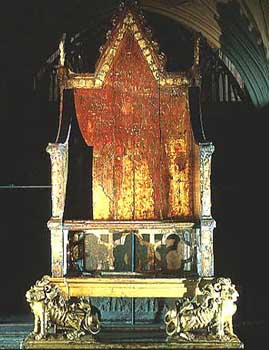
The Coronation Throne
The spectacle was far from over. The coronation feast was eagerly expected next. In Westminster Hall, the Duke of Norfolk entered riding a charger adorned in cloth of gold to evict the gathered spectators and make room for the feast. A table on the dias was laid for the king and queen. On the floor of the hall, four further tables were placed, one for the attending bishops, the second for the high ranking nobility, a third for the barons and the fourth for the ladies invited. Each filed in, pledging their loyalty before the king and queen before taking their seat. In all, over 3,000 people attended the feast. Richard III’s coronation was perhaps the last on this scale. Numbers catered for at the feast fell dramatically in subsequent years until it was abandoned altogether in 1830 by William IV on the grounds of cost. No monarch since has reinstated the event.

Westminster Hall Interior
Before the second course of the feast was served, the King’s Champion burst into the hall. Sir Robert Dymmock (whose family still hold the ceremonial position today) rode a destrier draped in red and white silk and wore armour of bright, pure white. He issued the traditional challenge to any who doubted King Richard’s right to rule and the room rang to shouts of ‘King Richard!’. With no challenge forthcoming, the Champion was served a covered goblet of red wine. Taking a draught, he cast the rest upon the floor, keeping the cup as his reward, and rode from the room.
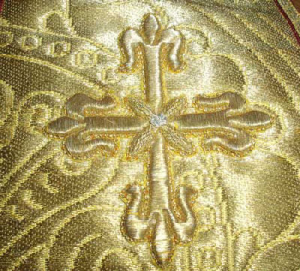
Cloth of Gold
The whole event had been an unmitigated success, perhaps the most lavish, well attended and best celebrated coronation Westminster Abbey had ever seen. At least it was in living memory. The Tudors are renowned for their use of spectacle as propaganda, but here King Richard III set a benchmark that even they would struggle to match.
Lost amid the rapturous pageantry were several notable anomalies, full of both promise and foreboding. With the exception of three earls who were minors too young to attend and a small handful of others, the entire English nobility turned out to celebrate the coronation. By comparison, the ceremonies both before, of Edward IV and after, of Henry VII, were bland, partisan affairs. Richard appeared to have embraced all of his new subjects. The Lancastrian Earl of Northumberland and Margaret Beaufort were in places of honour. Conciliation and the healing of old wounds seemed a real possibility. Without the benefit of hindsight, England must have appeared settled and happy.
However, examining the makeup of the procession more closely raises an interesting question that adds to the foreboding hinted at by Buckingham’s leading role. Thomas, Lord Stanley, proudly carrying the Constable’s mace, walked in a position senior to dukes and earls alike. An odd turn of events for a man known for a lack of loyalty that was unpalatable to Richard. Stanley had been involved in a long feud over possession of Hornby Castle with Sir James Harrington. Richard had, as early as 1470, taken Harrington’s side in the affair yet chose to lavishly honour Stanley. Was this a nod to the inescapable political reality that Edward IV had worked within? Stanley headed a veracious, up and coming family that boasted a huge force of men upon which they could call. It may have been a genuine attempt to build political bridges. If he was to rule all of England, niggling local feuds would have to be put to bed. Either way, an old enemy was in a place of high honour.
Behind Queen Anne walked another figure of some interest. She happened to be both the wife of Thomas, Lord Stanley and the mother of the final, glowing ember of Lancastrian hope in exile. Margaret Beaufort was a natural Lancastrian yet she too walked ahead of a duchess. Her son and his uncle had spent the last fourteen years in exile. There is evidence that Edward IV had been some way along the path of negotiating Henry Tudor’s return as a friend and his marriage to Edward’s own daughter, Elizabeth of York, Henry’s future queen. Was Richard intending to continue the attempt to bring the final stray within the fold? Or was he simply unable to escape the need to appease powerful enemies who remained irreconcilable? Henry Tudor was the final potential threat to the House of York. Imagine if he were made a friend…
Hindsight will tell us that the reign of King Richard III and his Queen Anne was not to last. Those honoured that day contributed to his downfall. Its attendants did not have this knowledge. For those who stood in Westminster Abbey, for those who sat indulging at the feast and for those who lined the streets cheering and soaking up the atmosphere, it was a spectacle like no other they had ever seen. It promised security, safety and a settled contentment for a country nursing ragged scars. Or perhaps the signs were there, just beneath the polished veneer, that this was a veil drawn over old, unresolved problems and new lurking threats, a bandage applied to ragged scars about to reopen once more.
Were there those who already plotted against the cheers of the crowds? Or could none have known the troubles to come as the streets of London joyously rang to a single call;
‘Long live King Richard III’
Matthew Lewis is the author of a brief biography of Richard III, A Glimpse of King Richard III along with a brief overview of the Wars of the Roses, A Glimpse of the Wars of the Roses.
Matt’s has two novels available too; Loyalty, the story of King Richard III’s life, and Honour, which follows Francis, Lord Lovell in the aftermath of Bosworth.
Matt can also be found on Twitter @mattlewisauthor.


June 22, 2013
Why Do I Love Ludlow?
I have always loved Ludlow. The town has always held a strong pull that I have never been able to quite explain. I can spend hours in the castle without getting tired of it. The town is a beautiful collection of narrows roads, Tudor buildings and artisan shops. Yet it is undoubtedly the history that draws me to this place. Perhaps it is the array of ‘What Ifs’ from the period of the Wars of the Roses that draws me to the town. I spent a day there earlier this week and thought I’d share some of my favourite things about Ludlow and some of my pictures.
Ludlow Castle was built in the aftermath of the Norman Conquest by the de Lacy family who retained it until the late thirteenth century. By marriage, the castle was acquired by the Mortimer family. Roger Mortimer was instrumental in deposing King Edward II in 1327, replacing him with the king’s son, for whom Roger acted as regent in his minority. Roger used his power to acquire much land in Shropshire and the Earldom of March, the border region between England and Wales. In 1402 Edmund Mortimer, the 3rd Earl of March, left Ludlow Castle to fight Owain Glyndwr’s Welsh rebellion, only to join them, marry Glyndwr’s daughter and die during a siege of Harlech Castle.
Richard, Duke of York acquired Ludlow Castle as part of his vast estates and it was to prove a pivotal site during the following fifty years. In 1459 as the Wars of the Roses escalated, the Duke of York made his base within the formidable walls of Ludlow Castle. His wife and younger children had been living at Fotheringhay Castle but Richard moved them to Ludlow for their security. Throughout the summer York’s supporters poured into Ludlow, including the Earl of Salisbury, York’s brother in law, and Salisbury’s son, the infamous Richard Neville, Earl of Warwick – the Kingmaker himself. York’s eldest sons were with him too, Edward Earl of March (later King Edward IV) and Edmund Earl of Rutland. All of these men roamed the grounds of Ludlow Castle formulating strategy and practising their fighting skills.
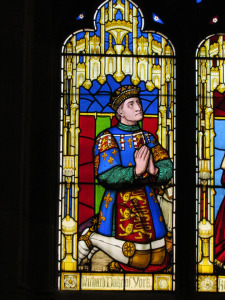
Richard, Duke of York
One small face who would have been watching was York’s youngest son, his namesake Richard. The boy celebrated his 7th birthday at Ludlow Castle on 2nd October. It is suggested that this was the first time he would have met his two eldest brothers. This boy was to go on to become King Richard III, and the events of the days that followed his birthday no doubt shaped the man he became.
The Battle of Ludford Bridge nominally took place on 12th October 1459, although there was in fact no fighting. During the night, the Calais garrison, which had been under the command of the Earl of Warwick, deserted and York’s forces were forced to retreat. King Henry VI himself led his army toward the battle and men were unwilling to take the field against the king himself. York and his son Edmund fled to Ireland. Salisbury, Warwick and Edward made for the south coast and escaped to Calais.
In the morning, the King’s army descended upon Ludlow. They found York’s wife, Duchess Cecily, with her two young sons George and Richard, standing alone on the steps of the market cross. The scene is remembered as one of supreme nobility on the part of the Duchess, refusing to cower and hide. For Richard, though, it must have been terrifying. Perhaps Cecily sought to save Ludlow by surrendering willingly, but she did not. As she was hauled to the King with her sons, the army ransacked Ludlow, drinking, stealing and raping until they were sated. The castle was looted of anything of value.
This episode in Richard’s life must have had an impact upon him. Abandoned by his father and his dashing older brothers, his uncle and his cousin in the night. Left to face an army. Doubtless his mother’s actions were noble but how must Richard have felt stood beside her as the rampaging army approached? Frightened? Undoubtedly. Determined not to show it? Perhaps. He was the son of a Duke and had his mother’s example to follow. Did he learn the unfair uncertainty of war that day as he saw Ludlow pillaged like a conquered French town? Did he learn the importance of nobility of action from his brave mother? Did he learn real fear? Did he learn that even family could not be trusted?
When Edward IV became king in 1461, Ludlow became a crown residence. In 1472, Edward sent his eldest son, Edward, Prince of Wales to Ludlow Castle. He set up a royal court there and he was schooled in the art of government, his household run by his maternal uncle, Anthony Woodville, Earl Rivers, currently appearing alongside his sister in the BBC’s The White Queen. For 11 years the Prince was installed at Ludlow Castle, until his father’s death. He left Ludlow then for his own coronation in London, an event destined never to take place.
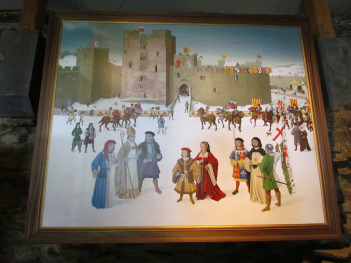
The Arrival of Prince Arthur
In 1501, Prince Arthur, eldest son of King Henry VII, older brother of the future King Henry VIII and Prince of Wales was also installed at Ludlow Castle to be prepared for power. He arrived with his new wife, Catherine of Aragon but fell ill the following year, dying at Ludlow Castle on 2nd April 1502. Arthur’s body was buried at Worcester Cathedral (another beautiful place well worth a visit!) but his heart was buried in St Laurence’s in Ludlow. Catherine of Aragon’s daughter Mary later spent three winters at Ludlow Castle between 1525 and 1528.
After the Civil War the castle fell into disuse when governance of the Marches was centralised in London. In 1772 the Earls of Powis began renting the castle from the Crown, purchasing it in 1811. The Earl of Powis still owns the castle today and although disuse saw it fall into ruin, it is a powerful monument to a bygone age. Walking the grounds once paced by the Duke of York, the Kingmaker Earl of Warwick, Edward IV, Richard III, Edward V, Prince Arthur, Catherine of Aragon and Mary I amongst others is enough to send a tingle up the spine of one as obsessed with this period as I am.
So Ludlow Castle offers some tantalizing historical ‘what ifs’. What if battle had been given at Ludgate Bridge? What if York had won and brought a swift end to the Wars of the Roses? What if Henry had won? What if Edward V had been crowned? The influence of his mother’s family at Ludlow ultimately threatened his position. What if Prince Arthur had lived and become King Arthur with his Queen Catherine? There would have been no Henry VIII and all that came with him. Ludlow was key in the outcome of all of these questions.

The Church of St Laurence, Ludlow
St Laurence’s Church is a short stroll across the market square from the castle and is a beautiful medieval parish church. A large stained window celebrates Ludlow’s famous medieval inhabitants the Duke of York, King Edward IV, Edward Prince of Wales and Arthur Prince of Wales. The church is currently undergoing restoration and preservation work but you are guaranteed a warm welcome and a enjoyable time in a stunning church.
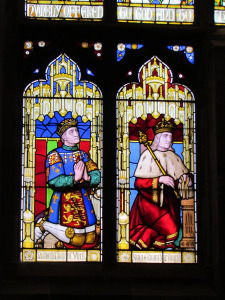
Richard, Duke of York and King Edward IV

King Edward V and Prince Arthur
Castle Lodge on the other side of the market square is a striking building dating from the thirteenth century. Once a prison, it has also been a hotel and is currently in private hands. It is open to the public for a small charge which contributes toward its upkeep.
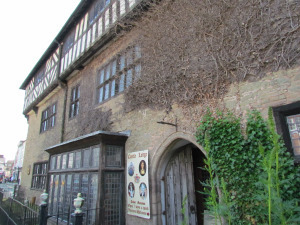
Castle Lodge
Ludlow is also a centre of fine dining, boasting a Michelin starred restaurant, ancient pubs and butchers offering venison steaks and boar burgers. Add to that an array of shops, a market, the Ludlow festival (at which I am mourning the loss of the Shakespeare play until this year performed against the backdrop of the castle interior) and the beautiful Shropshire countryside and you will not be disappointed by a visit to Ludlow. I might even see you there!
Matthew Lewis is the author of a brief biography of Richard III, A Glimpse of King Richard III along with a brief overview of the Wars of the Roses, A Glimpse of the Wars of the Roses.
Matt’s has two novels available too; Loyalty, the story of King Richard III’s life, and Honour, which follows Francis, Lord Lovell in the aftermath of Bosworth.
Matt can also be found on Twitter @mattlewisauthor.


June 2, 2013
William Shakespeare’s Richard III – The Convenient Villain
William Shakespeare’s play The Tragedy of Richard the Third is a masterpiece in the depiction of evil and the study of the psychology of the anti-hero, the villain we love to hate to the point that we almost hope they succeed. Yet we may have been deceived by Shakespeare’s play because he may not have meant us to see King Richard III in it.
It is beyond doubt that Richard III is replete with errors of all kinds; factual, chronological and even geographical in its efforts to damn King Richard to its audience; and it succeeds. This is the image of King Richard that has imprinted itself onto our collective consciousness; the scheming, evil murderer, worst of all, murderer of children. Yet Shakespeare’s genius in passing fiction into historical fact may have been an accident, or at least an unintended by-product or convenient cover for what he was really asking his audience, and his Queen, to think about.
The play was written in the early 1590’s, probably around 1593 and it is important to consider the context in which Shakespeare was writing. The concerns of his contemporaries were great and growing. There was still religious upheaval, with no settlement reached in the country during the sixty years since Henry VIII’s Reformation. Queen Elizabeth I was aging and clearly not going to produce an heir. The question of the succession was growing like a weed, out of control, and no one was tending to it openly, including the Queen. Elizabeth ardently refused to address the issue but it was the proverbial elephant in the kingdom. The religion of the next monarch was a vital matter to the people of England. Transitions from Edward VI to Mary, Protestant to Catholic, and back again to Elizabeth’s Protestantism had been violent cataclysms tearing at the seams of Tudor England and another point of uncertainty was approaching.
Shakespeare is widely believed to have been a devout Catholic to the end of his life, forced to hide his faith but doubtless keen to see a Catholic monarch upon the throne after Elizabeth. He was close to his sponsors the Earls of Essex and Southampton who were known Catholics. If we can view Hamlet as a call to arms for English Catholics then Richard III contains similar thinly veiled undercurrents. William Shakespeare appears to have been happy to promote the Earls’ Catholic cause in his writing and skilled at hiding it. So who was Shakespeare aiming his quill at? I believe his audience were meant to see, and at the time would have clearly understood that they were meant to see, Robert Cecil.
Robert Cecil was a hunchback. In 1588 Motley’s History of the Netherlands described Cecil as: ‘A slight, crooked, hump-backed young gentleman, dwarfish in stature’ and later spoke of the ‘massive dissimulation (that) … was, in aftertimes, to constitute a portion of his own character’. Motley could almost have been describing Shakespeare’s King Richard III. Robert was the son of William Cecil, Elizabeth I’s lifelong advisor and Lord Privy Seal. In 1590 Robert became Secretary of State and was being groomed by his father to succeed him as the closest advisor to the monarch. After William Cecil died in 1598, Robert succeeded him as Lord Privy Seal but as early as the beginning of that decade, when Shakespeare was writing, the Cecils were operating a covert campaign to see James Stuart, King James VI of Scotland, a Protestant, succeed Elizabeth. Read in this context, the themes and dark threats of Richard III take on a new meaning.
King Richard III was perhaps an obvious candidate for the representation of evil. He had lost his life and his throne at the Battle of Bosworth to Elizabeth’s grandfather, King Henry VII. On 22nd August 1485 the monumental Plantagenet dynasty had crumbled and the Tudor rose had flourished in the remains. Henry VII had married Richard III’s niece, Elizabeth of York. As a daughter of King Edward IV, slandering this portion of the Yorkist Plantagenet family was thoroughly out of bounds – Elizabeth of York was Elizabeth I’s grandmother. Richard III sat alone between Edward IV and Henry VII with none to defend him. Henry had made great play of rescuing the country from Richard so he was an obvious villain for a Tudor writer.
The first thing to consider is the physical representation of King Richard. Shakespeare shows us a hunchback with a withered arm. Whilst stories of King Richard having uneven shoulders existed and Sir Thomas More had used the word ‘crookback’ in his Historie of King Richard III, Shakespeare may have exaggerated these into the limping hunchback of his play, but Robert Cecil was, in fact, a hunchback. The withered arm seems to be a fabrication, perhaps a hint that it was not really Richard. I imagine the gasps when he walked out on stage for the first time and people nudged each other with knowing looks, whispering “It’s Robert Cecil!” furtively, the knowledge spreading like fire through the crowd.
The warnings of Richard III were plain to see. Richard had upturned the natural order, murdering his brother amongst others until he stole the Crown from his nephew, slaughtering the two young Princes in the Tower and poisoning his own wife. This upsetting of the correct way of the world had seen Richard king for a while but had ended in disaster, with him betrayed and killed at Bosworth and his dynasty blown to the wind. Ultimately, Richard was the architect of his own demise and I believe that Shakespeare was offering a warning that Robert Cecil was to become the architect of the downfall of the Tudors.
Richard is an appealing villain – he is funny and clever. We are forced to examine our attitude to the blatant evil played out before us. We almost like him, and we are supposed to. Elizabeth I liked Robert Cecil, a man she called her ‘little imp’ and Shakespeare was warning that this veil of amiability hid dark schemes that would doom the Crown. Namely, Cecil’s plot to see the Scottish Protestant James Stuart as King of England. Richard is the archetypal anti-hero. In his opening soliloquy he tells us all what he is planning to do, that he is ‘determined to prove a villain’, drawing us in so that we feel like we are his co-conspirators, accessories to what follows since none of us leap up to stop him. Complacency in the face of such deeds will bring ill upon the kingdom, as will allowing Cecil the room to plot a Stuart succession.
Another key theme of the play is the balance of free will against fatalism. Richard appears to be the master of his own destiny, to be driving events, giving us a Machiavellian lesson in power politics. To balance this, Richard also appears to act as though God intends the outcomes of his actions, to try and use religion to circumvent the unpleasant nature of his actions. His professed free will is an illusion. So religion becomes a central theme, man’s desire for free will against God’s plan. Cecil’s desire for a Protestant succession versus a return to the ‘correct’ religion, Catholicism. Robert Cecil is acting contrary to God’s will to try and get what he wants.
As Elizabeth I grew older and had no heir, the issue of the succession was a rising concern to the whole country. The last time that there had been a serious issue with the succession was following the death of Elizabeth’s brother Edward VI, but this was possibly a little too close for comfort. Before that, the seizure of the throne by Richard III from his nephew Edward V had thrown the country into political convulsions. Edward IV had died leaving his twelve year old son in the care of his uncle Richard. On the basis of illegitimacy, Richard had taken the throne from his nephew. This had led to civil war and, in Tudor mythology, to the need for a saviour to right the wrongs. Shakespeare was warning Elizabeth that she risked plunging the country into darkness that would lead to a violent restitution. Her duty was to ensure a smooth transition. She was failing to do this and it was the country that would pay.
Read in this context, the context in which Shakespeare’s audience would have watched it, the play becomes a moral warning to Queen Elizabeth about the effects of the uncertain succession and of allowing Robert Cecil to follow his own course. Shakespeare and his Catholic sponsors were keen to see a Catholic monarch return England to the true religion. They certainly did not want Cecil, to whom the Earl of Essex was openly opposed at court, orchestrating the Protestant succession of a Scottish monarch. The Earls of Essex and Southampton later rebelled, trying to capture the Queen in order to force their demands upon her. Both were executed after their failure. Elizabeth never named an heir. Cecil got his Stuart succession and served James I, being elevated as Earl of Salisbury. Shakespeare became a legend. Richard III became a villain. Perhaps by accident.
Matthew Lewis is the author of a brief biography of Richard III, A Glimpse of King Richard III along with a brief overview of the Wars of the Roses, A Glimpse of the Wars of the Roses.
Matt’s has two novels available too; Loyalty, the story of King Richard III’s life, and Honour, which follows Francis, Lord Lovell in the aftermath of Bosworth.
Matt can also be found on Twitter @mattlewisauthor.


April 13, 2013
The Kingmakers
On 14th July 1471, Richard Neville, 16th Earl of Warwick, was killed at the Battle of Barnet. It brought to an end the career of a man who was, in his day, the most powerful non-royal noble in the kingdom. Initially loyal to King Henry VI, Warwick began to support the Duke of York following a dispute with the Duke of Somerset. He had control of the garrison at Calais which made him a formidable force. The Calais force was the only standing army in England at the time, the only retained force of trained soldiers in the country. And they were Warwick’s men. When the Duke of York was killed at the Battle of Wakefield, Warwick continued to support his house and was instrumental in seeing Edward IV take the throne from the hapless Henry VI.
Warwick was now the king’s right hand man. Power and offices flowed to him. He began to negotiate a French alliance to be sealed by Edward’s marriage to a French princess. At Council on day, Warwick’s world began to crumble. Imagine the scene as he proudly reported the progress of his negotiations and the almost concluded wedding arrangements, only for Edward to casually announce, in his “Oh, did I forget to mention…” way, that he was already married. He had married a widow considered below him who brought with her children and relatives who were later to prove divisive at Edward’s court. By the standards of his day, the slight upon Warwick’s honour was considerable and he did not take it well. He had lost face before the Council and before the French and he was not the kind of man to allow this to pass.
As tension between the king and his greatest subject grew the threat of a return to civil war gripped the country. Warwick sought out Margaret of Anjou, Henry VI’s wife and, after over half an hour on his knees before her, she agreed to allow him to help place Henry back upon the throne. No doubt Warwick saw an opportunity to control Henry in a way he could never control Edward. Warwick recruited Edward’s brother George, Duke of Clarence to his cause, but his other brother Richard, Duke of Gloucester, who had been raised in Warwick’s household, refused to betray his king. Warwick had two daughters. The eldest he married to George in spite of Edward’s prohibition. The youngest he wed to Henry VI’s son and heir. One way or another, Warwick would have his grandchild upon the throne.
Henry VI emerged from the Tower of London, blinking, bewildered and suddenly king again. Eighteen months later, Edward had regrouped and retook his throne. Barnet was the first engagement in the process and Warwick met his end there aged 42. He was later referred to as The Kingmaker for the way in which he appeared to pick and choose who would be king. This perhaps overstates his achievements on this front. He aided Edward in seizing he throne and then helped Henry regain it, but could not help him retain it, a fact that cost Henry his life when Edward returned to London.
This made me wonder: Who were the other Kingmakers and is there one I would consider The Kingmaker ahead of Warwick? There is, and I fear that I may have to apologise to some for my conclusion, so I shall put it off for a while.
Kingmakers go back a fair way, a most had one thing in common. The first that strikes me is the Empress Matilda, who was deprived of the throne that her father Henry I left to her only to fight for years and years until she saw her son, Henry II on the throne. Without a doubt Matilda’s drive and commitment made her son king. Perhaps she accepted that England was not ready for a female king but she had a son for whom she won a kingdom. Henry’s own wife, Eleanor of Aquitaine, would also try to select the next king, encouraging Richard to seek power sooner rather than later as Henry preferred their youngest son, John. Eleanor assisted Richard’s revolts and was imprisoned for long periods by her husband. In the end, though, she got her way and Richard I followed Henry as king.
Isabella of France was wife to one king, Edward II, but saw to it that her son became King Edward III before his father was dead. She led the rebellion that saw her husband abdicate in favour of their son and is rumoured to have arranged her husband’s death to ensure that he stayed out of the way.
There is also Margaret of Anjou, wife of Henry VI. With her husband weak and frequently unstable, even descending into prolonged periods of catatonia, she was left to fight to keep him on the throne. She opposed York when he was made Protector of the Realm, perhaps fearing that his eye may be caught by the glinting gold of the Crown. She denied the need for a Protector and when Henry agreed to make York his heir in preference to his own son, she was outraged. It was Margaret that championed the Lancastrian cause throughout the Wars of the Roses as she sought to preserve her son’s inheritance. When Warwick dismayed, it was to Margaret that he turned, it was to Margaret that he paid homage in order to secure her support to return her husband to the throne and her son to his inheritance. After Warwick’s death, Margaret continued until, shortly after Barnet, she lost her son at the Battle of Tewkesbury and her husband when Edward regained his grip. She had played a part in Henry’s re-adaption every bit as much as Warwick.
In each of these cases, the Kingmaker was a woman, a wife and mother. They have each been viewed somewhat harshly, dubbed the She Wolves of history because although English law did not forbid female succession as French Salic Law did, the exercise of power by a woman was considered unseemly and was not something the great men of the time could easily come to terms with. However, Warwick’s achievement was in switching kings at his will. Can anyone match that? I think so.
Thomas, Lord Stanley, as I have discussed in previous posts, made a career during the Wars of the Roses of backing the winner. And he got very rich doing it. At various times he used the immense retinue that he could call upon to support Lancaster or York depending upon how the wind blew. He got rich under Edward IV and then Richard III. At Bosworth, he was presented with two options as he looked down upon the field of battle. His king demanded that he do his duty. His step-son begged his assistance to win the throne. He eventually came down on the side of his step-son. The legend goes that it was Lord Stanley who placed the crown upon Henry’s head after it had been knocked from Richard’s. He certainly prospered under the new regime. His family still hold the title Earl of Derby that he gained for his part in Henry’s victory. He had played the game under Henry VI, Edward IV, Richard III and Henry VII and won, often appearing to turn the tide and always wooed for his apparent ability to do so. Yet this was probably done more in the interest of self preservation and family gain than a real concern for who was upon the throne. Stanley though is a definite contender for Kingmaker.
And so I can put it off no longer. There is one I would consider the ultimate Kingmaker. There is one whose dedication saw a dynastic change that shaped England. I doubt any Ricardian will thank me for this, but the accolade must go to Lady Margaret Beaufort. As the other She Wolves had done she fought for her son. Margaret was married to the half-brother of King Henry VI and bore a son to Edmund Tudor, who died before the child was born. Margaret was only thirteen when her son was born at Pembroke Castle on a cold, stormy night. She married twice more but bore no more children. Physicians believed that the birth of Henry caused irreparable damage that prevented her from carrying more children. Protected by Edmund’s brother Jasper, she weathered the beginnings of the Wars of the Roses until the Lancastrian cause was lost. When Henry was fourteen, his uncle Jasper whisked him away to Brittany and into exile where he remained for a further fourteen years. Margaret sought tirelessly to see Henry returned but Edward IV was happy to keep the vague Lancastrian blood in Henry’s veins at arm’s length. Richard III appeared to think likewise until Henry tried to invade in autumn 1483. It was named Buckingham’s rebellion, but its intention was clearly stated. To put Henry Tudor on the throne. That invasion failed and Margaret was attainted for her conspiracy, placed in the custody of her current husband, who happened to be Lord Stanley. She does not appear to have ceased working. Tudor swore to marry Elizabeth of York, daughter of Edward IV, to unite Lancaster and York and heal the old wounds.
In 1485 he invaded in earnest at met Richard at Bosworth. When his mother’s husband finally joined the battle on his side, Henry won the day, against all expectations. A twenty eight year old Welshman who had been in exile for half his life and whose only slim royal claim was based upon his mother’s descent from John of Gaunt, son of Edward III (a branch specifically precluded from succession when they were legitimised after John married the mother of his illegitimate children), was now king of England. The Plantagenets had reigned for over three hundred years but this was the beginning of Tudor England. There can be little doubt who Henry owed his throne to. Margaret Beaufort had dedicated her life to the son that the House of York had kept her separate from. She took her revenge and her son took the throne. Margaret, then, was not just Kingmaker, but the maker of a dynasty. The mother of Tudor England, grandmother to Henry VIII and great-grandmother to Edward VI, Mary and Elizabeth I. The Stuarts traced their lineage back through Henry VII to Margaret. Her Kingmaking was not fit of pique. It was the culmination of her life’s work. She may not have placed and replaced monarchs at will, but she unseated a dynasty and founded the most famous one in English history.
So, who is your Kingmaker?
Matthew Lewis is the author of a brief biography of Richard III, A Glimpse of King Richard III along with a brief overview of the Wars of the Roses, A Glimpse of the Wars of the Roses.
Matt’s has two novels available too; Loyalty, the story of King Richard III’s life, and Honour, which follows Francis, Lord Lovell in the aftermath of Bosworth.
Matt can also be found on Twitter @mattlewisauthor.







